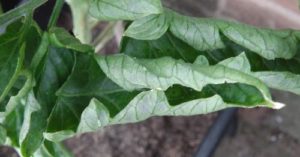Tomato Plants and Stress Related Problems
When the weather is poor, many home growers experience problems with plant growth. Many of these problems are related to plant stress.
Here are just a few of the problems that growers regularly experience – many of these are stress related:
- Thin leaves
- Withering leaves
- Scarce foliage
- Poor flower/fruit set
- Smaller fruit than usual
- Poor vigour
- Undersized plants
- Stocky shorter plants than usual
- Blight can be rought on earlier when plants are stressed and resistence is low

Of course blight isn’t caused by stress, but a plant that is stressed is likely to show symptoms much sooner than a plant that is stress free.
Those in Scotland often have a particularly bad time of it with dull wet conditions. Many who grow south of the border sometimes experience very hot and very wet conditions – all of which create inconsistency – exactly the sort of conditions that tomato plants do not like!
When tomato plants experience such conditions they become stressed and this causes erratic growth.
Types of stress
Water stress, heat stress, light stress, salt stress from over feeding … the list goes on!
Given the varied weather we regularly have in the UK, it’s amazing we are able to grow tomatoes at all!
Thankfully, most seasons are not too extreme and we are able to get reasonable results. The important thing is to try and be one step ahead of the weather and prevent or limit the stress that tomato plants experience – difficult if growing in a greenhouse and even more so if growing outside.
Two of the biggest misconceptions when growing tomatoes are:
- Plants need full sun from morning to evening
- Plants need lots of water
Both are true, however, too much hot sunshine and over watering will stress plants greatly.
Of course in extreme conditions, too much sun or too much rain is exactly what we get!
Wetting Agent for Dry Soil
When soil is cracked and dry, it is difficult to re-wet and we experience water running through the path of least resistance – through the cracks and out of the bottom of a pot without touching the sides – so to speak. Using a wetting agent helps and we can make our own by adding just one drop of washing up liquid to the watering can.
Draining Saturated Pots
When large pots and containers are saturated with water, standing them on blocks an inch or two off the ground will help drain the soil.
Blight Resistance
When there are periods of wet weather during August, and the weather is warm, blight is most likely to strike!
It’s at times like these that the blight resistant Crimson Crush and Mountain Magic varieties are worth the extra expense – both varieties are available to buy as seeds this season..
Here’s a link to the background behind the variety Crimson Crush.
One of my favourite bush varieties is Red Alert and I was pleasantly surprised to read that the plant breeder, Simon Crawford, who was responsible for Red Alert, is also jointly responsible for Crimson Crush.
Treating Blight
The only steps that can be taken at the first sign of blight, which shows as brown patches on leaves, are to remove all affected leaves and spray with a systemic fungicides. Bordeaux mixture is also good for prevention. This will slow down the disease and hopefully a plant will still produce some edible tomatoes before blight takes over completely.
Garden chemicals are regularly updated or even discontinued owing to new regulations.
On a Different Note – The Biodynamic Calender
Biodynamics studies the best time for sowing and planting according to the lunar calendar.
Having mentioned saving seed last week, it turns out that the best window for tomato seed preparation this season, is this Saturday and Sunday – 15th/16th August. Both days are ‘fruit days’.
I have not yet tried growing according to the lunar calender but it’s a fascinating subject and well worth further investigation. Thank you Rhys for the information.
People have been sowing seeds for thousands of years – I expect that our ancesters would have a thing or two to teach us.
See Also:


Rob
Hi Nick, thank you for another fascinating newsletter.
I note Rhys Jaggar is saving seed from Rosada. I have grown Rosada for many years but only from freshly-bought seed. I may be wrong but I think Rosada is an F1 hybrid and therefore unsuitable for saving seed.
Kind regards,
Rob.
Nick
Hi Rob, you are correct … Rosada is an F1 Hybrid but it’s ok to save seed from Hybrids if you don’t mind a few surprises or inconsistencies the following season!
richard
had the first tomato small as usual but tasty,no problems yet!?????.
frank cullinan
Thanks Nick,
A very instructive article, as usual, and tells me more than I was aware of regarding my poor stressed-out tomatoes.
I thought I had covered all angles, but your wee note guides me a bit more.
Here in Ireland it was said if you feed the plants with Guinness you will have eating and drinking with your tomatoes, but I think I will follow your guidance.
Regards,
Frank
Nick
Hi Frank, an alcoholic tomato would make me a fortune but I have heard that tomato wine is very drinkable – I must find a good recipe!
Cheers,
Nick